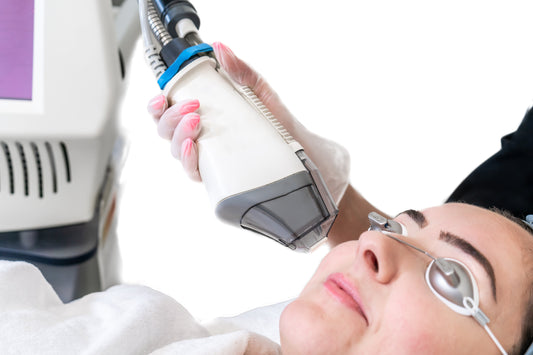Despite how many people deal with hair loss, there are a ton of questions left unanswered on the Internet – especially when it comes to advice from medical professionals. One question in particular continues to cause confusion: can men regrow hair after hair loss? Below, Dr. Anthony Nuara, MD PhD FAAD answers some of your most pressing questions surrounding the causes of hair loss in men and the topic of regrowth after loss.
Q: What Causes Significant Hair Loss in Men?
Hair loss in men (like women) is multifactorial, but genetics, hormones, and aging all play a huge part. For men, a hormone called dihydrotestosterone (DHT) is often the root of the problem.
Men are dependent on DHT for sexual development and prostate health. However, their hair follicles also convert testosterone to DHT, which can have a negative effect on hair health. Over time, exposure to DHT causes the follicles at the frontal scalp margin and the vertex of the scalp to go through a process called miniaturization – meaning the follicles gradually shrink. As they continue to constrict, it becomes harder for them to grow hair, which leads to thinning. The prescription drug finasteride and the herb saw palmetto block the conversion of testosterone into DHT. Foundation Skincare’s UnTangled Hair Supplement is formulated with optimal amounts of saw palmetto to help minimize hair loss due to DHT.
While DHT plays a large role, it’s also important to note that genetics, nutrition, and other factors impact hair loss as well.
Q: What Can You Expect With Male Pattern Baldness?
The extent of male pattern baldness is variable, but generally follows the patterns proposed by Hamilton and Norwood in the 1970s. This includes gradual thinning of the vertex (also known as the crown) and recession of the frontal margin (also referred to as a receding hairline). In order to maintain your hair, it’s best to start treatment as soon as possible when you first notice signs of male pattern baldness. This is why Foundation Skincare has developed the UnTangled Hair Supplement and the Hair Serum, a powerful duo that offers visible results in 90 days.
Q: Is Hair Loss in Men Reversible?
Hair loss is reversible to a degree, but we generally prefer to stop it early. It is much easier to maintain your hairline than it is to reverse it. That’s why we say it’s never too early to start using a supplement and serum in your hair care routine.
Q: Is Hair Thinning Inevitable?
Everyone will experience thinning to some degree as they age. This is a consequence of normal hormonal shifts, as well as cellular senescence. Your skin and nails will thin over time, as will your hair. Maintaining the building blocks for these components can help delay this process, which is why we’ve made this the basis for the formulations of our hair loss treatment products.
UnTangled Essentials Kit
• Engineered to work in tandem
• Visibly fuller hair in 90 days
Best Treatments For Men Experiencing Hair Thinning & Loss
There are a variety of treatments available that can help slow down hair thinning – and in some cases even promote new growth.
If you’re looking for a dermatologist-formulated non-prescription treatment, you can also consider getting nutritional support through the Foundation Skincare UnTangled Supplement. This supplement was designed to fight hair loss from multiple angles. Saw palmetto helps block DHT, while ingredients like vitamin C, marine collagen, and horsetail extract provide the body with the tools needed to increase keratin production and revitalize growth.1
Since nutritional deficiencies also play a role in hair loss, the formula contains many of the vitamins and minerals that are tied to hair loss when the body is deficient.2 This includes biotin, zinc, iron, selenium, and vitamin D. Whatsmore, it is completely safe to use alongside other treatments for hair loss for optimal results.
Under the guidance of a board certified dermatologist, you can consider using minoxidil (either topically or orally) or 5-alpha reductase blockers (like finasteride or dutasteride). Minoxidil helps boost growth by increasing the time spent in the growth phase of the hair cycle,3 and by stimulating blood circulation. 5-alpha reductase blockers inhibit the enzyme that helps with the conversion of testosterone into DHT.4 Please keep in mind, there are drawbacks to this drug. Many choose not to use minoxidil, as side effects can include an initial period of hair shedding, hair growth in unintended areas and contact hypersensitivity. Oral minoxidil can be associated with systemic side effects and should only be taken under supervision of a board certified dermatologist or cardiologist familiar with its use.
There is also the Foundation Skincare Hair Serum, which is formulated to address a variety of triggers that can lead to hair loss. A blend of proven ingredients (including Capixyl, Stimucap, and saw palmetto) fortify the follicles and cuticles, helping to promote growth and minimize loss and breakage. Like all Foundation Skincare products, these products only contain highly-effective, proven ingredients – no filler or “fluff” ingredients.
As mentioned, starting treatment in the early stages of hair thinning will give you the best possible results. By acting swiftly and using one or more of these treatments, you can help slow the thinning process, and may even be able to promote growth.
References:






